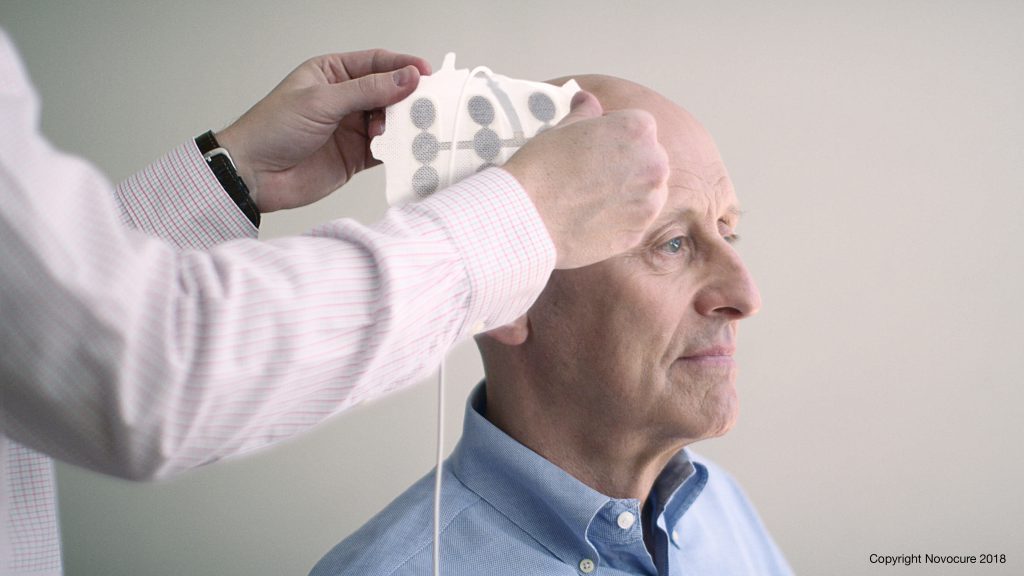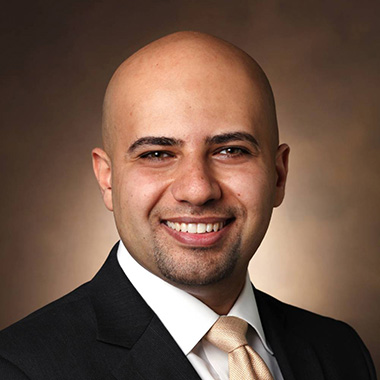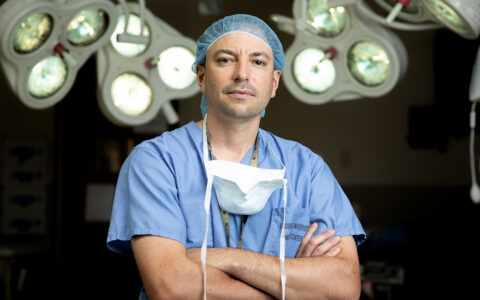Tumor treating fields (TTF) harness electromagnetic fields to create polarity and interfere with cell mitosis when targeted at the tumor or tumor bed. When added to the treatment regimen, TTF can enhance efficacy of other therapeutics. In a randomized Phase 3 trial of 695 newly diagnosed glioblastoma (GBM) patients, TTF plus temozolomide was demonstrated to be superior to temozolomide alone in the adjuvant setting. TTF has shown success in patients internationally and is now classified as Category 1 in the standard of care for treatment of adults with GBM.
“With TTF added during the second chemo phase, we’re seeing better outcomes in glioblastoma patients. Nothing else comes as close to prolonging survival,” said Albert Attia, M.D., associate professor of Radiation Oncology and Neurosurgery at Vanderbilt-Ingram Cancer Center.
Attia is now working with investigators at Vanderbilt and other centers to study the use of TTF for treatment of small cell lung cancer (SCLC) and other aggressive cancers.
Fewer Side Effects with TTF
TTF causes minimal damage to healthy cells, with mild to moderate skin irritation the most common side effect reported. With alternatives like prophylactic cranial radiation (PCI), patients often have cognitive impairment.
“The beauty of TTF is that patients record no detriment to quality of life. Neurocognitive abilities are not impaired; scalp irritation is the biggest complaint.”
While TTF treatment may be less invasive than chemotherapy or PCI, compliance is more difficult. TTF is delivered to the brain by a patient-operated, portable medical device. Patients must keep their heads shaved and apply TTF probes daily for as long as possible. “With 18 hours of treatment per day, you really start seeing improvement,” said Attia. “However, the most improvement comes from wearing the device for 20 to 22 hours.”
Another downside is the length of treatment. “Currently there is no endpoint,” said Attia. “This takes a mental toll on the patient because they have to continue treatment indefinitely — it’s tough to stay motivated. I would like to make that easier.”
The Future of TTF
TTF is now being explored as a possible intervention for other aggressive cancers, including SCLC and pancreatic cancer.
SCLC patients are at high risk of incurring brain metastasis in Stage 4. PCI is used to prevent this spread, but for many patients metastasis reductions come at the cost of memory decline with PCI. In pre-clinical studies, TTF has been shown to kill small-cell lung cancers. “The question is ‘Will TTF prevent brain metastases?’” said Attia. “Because of its negative side effects, we want to deliver brain radiation when the patient actually needs it.”
Attia is principal investigator at Vanderbilt for a multi-site feasibility study to determine the effects of TTF in the treatment of SCLC. The trial will administer TTF to patients with SCLC who have not yet developed brain metastasis, and for whom PCI is not standard of care. “We need to find out if TTF helps prevent metastasis and if it will be safe,” said Attia.
The next study, he says, will compare the benefits of PCI and TTF. Attia hopes TTF will provide a better alternative to PCI. “Quality of life matters as much as survival with most cancer patients,” he said. “If this therapy works, we hope to get rid of PCI altogether.”
“TTF offers hope for patients with aggressive tumors,” said Attia. “We are optimistic that these new trials will expand its use — improving both survival rates and quality of life for survivors.”
For more information on the SCLC trial, contact Vanderbilt Radiation Oncology at 615-322-2555.





